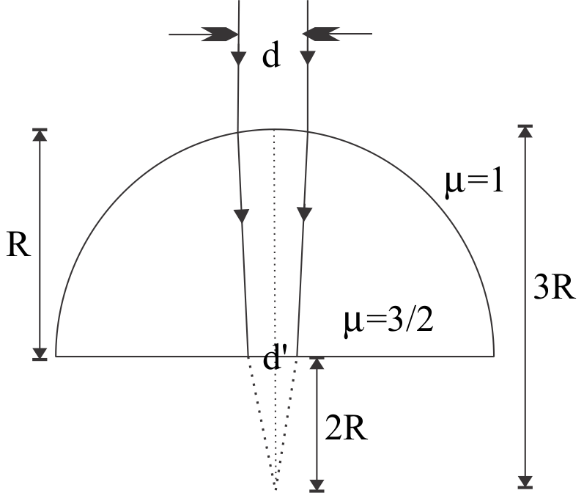Question
Question: Three mediums of refractive indices\[{\mu _0}\], \({\mu _1}\) and \({\mu _2}\) are shown in fig. \(\...
Three mediums of refractive indicesμ0, μ1 and μ2 are shown in fig. (μ1>μ0 and μ2>μ0). The lamps A and B are placed at the bottom and top of first and third mediums of the same thickness. If the bottom layer of the middle medium is illuminated for a circle of half of the radius for which the upper layer of this medium is illuminated, the relationship between μ1 and μ2 is (givenμ0=1):

(a) 2μ2=μ12+3
(b) μ2=μ12+4
(c) μ2=μ12+2
(d) μ2=μ12+1
Solution
Hint So to find the relationship between them, we will use some of the trigonometric formula and the geometry properties. So as we know from the figure sinc=μ1andtanc=μ2−11. So by using these two, we will find the relation between R.I.
Complete Step By Step Solution
As we have seen in the figure, let’s first make the ray diagram and see the angle and the distance made.
As we know,
sinc=μ1, and
tanc=μ2−11
So from the figure, we can write it as
tanc1=hr
Here,
r, is the distance
And h, will be the height
So,
⇒r=htanc1
Now for c2
tanc2=h2r
And also it can be written as
⇒2r=htanc2
So from the formula, we can write the ras
⇒r=h×u12−11
And for μ2, it can be written as
⇒2r=h×u22−11
Now on dividing both the above equation, we get
⇒21=μ12−1μ22−1
Now on removing the under root, we get
⇒41=μ12−1μ22−1
So by doing the cross-multiplication, we get
⇒μ12−1=4μ22−4
And on solving the above line again, we get
2μ2=μ12+3
Therefore the option A is correct.
Additional information Well, an electromagnetic wave is only photons with an Energy. That kind of wave only interacts with the electrons of the material. Only on very high frequencies (gamma-ray) can interact with the nucleus (protons).
Then the refractive index only depends on the electrons on the material and how to interact with the wave. In a quantum theory, photons interact with the electrons, but there isn't a solution to that problem. Even a photon interacting with an electron is a hard problem, imagine a lot of photons interacting with a lot of electrons.
But the refractive index is not unique. Depends on wavelength and this is well known about optics. On the lens, red light has a different focal point than blue light, that's called "chromatic aberration".
If different wavelengths have a different refractive index, means that different wavelengths have different speed of light.
Note The refractive index is measured as the change of velocity of light through water and the sample, the electrical permittivity of the material and the magnetically permeability of the material define these differences If the light is propagating through a medium then the higher the refractive index of the medium lower is the velocity of light and vice versa. The most important physical significance is the fact that we can see through many transparent or partially objects like glass.
